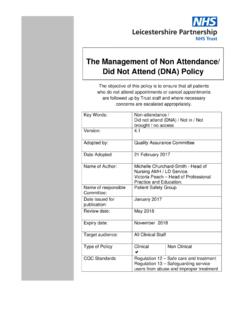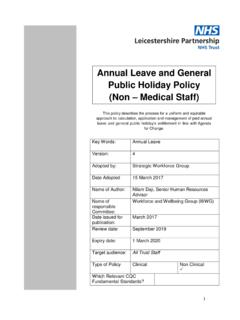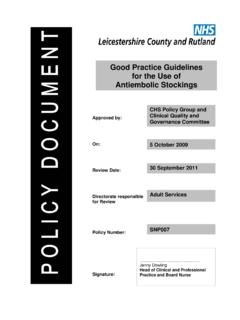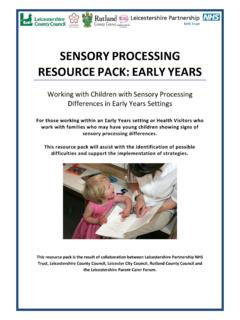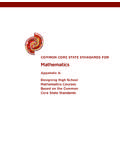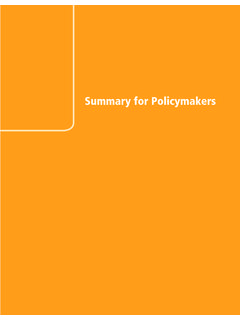Transcription of Adult Autism Pathway - Leicestershire Partnership …
1 Page 1 of 39 Adult Autism Pathway Page 2 of 39 Pathway Overview Suspected ASD Initial screen Referral for ASD diagnostic workup ASD diagnosis confirmed Intervention Package Stepped care model Discharge Discharge Transition Pathway Referrals Info for Referrers: Core features Other features Mental health difficulties Presentation in Primary Care Info for Carers/Patients Useful contacts Screening Tools/Checklist People with LD People without LD Standard Diagnostic Workup Advanced Diagnostic Workup References Needs Based Assessment Outcome Measures Service user reported outcome measure Outcome star Referral to Assessment - 6 weeks in LD Assessment to Diagnosis - 3 months in LD Standards/ Professional skills/ Training required Page 3 of 39 Background Autism is an umbrella term for a group of complex neuro-developmental conditions.
2 Characterised by qualitative abnormalities in reciprocal social interaction, social communication, imaginative activity, and a restricted, repetitive repertoire of interests and activities. These characteristics are known as the triad of impairments (Wing (1979)). Autism Spectrum Disorders (ASD) and are found throughout the whole IQ range, from profound intellectual disability right up to superior levels of intellectual functioning. Presentation will vary in line with intellectual level, however the core features described above will be present in all cases. Table 1 below provides an overview of the presentation of ASD across the IQ range.
3 Table 1 Feature of ASD IQ Range Severe/Profound ID Normal/Superior IQ Social Impairment Aloof Passive Active but odd Overformal, stilted Communication Mutism/Echolalia Difficulties with humour/ prosody Behaviour Simple Stereotypies Complex rituals Sensory Problems Hyposensitivity Hypersensitivity Currently three major clinical subgroups are recognized: Childhood/Classical Autism , High Functioning Autism (HFA), and Asperger Syndrome (AS). AS and HFA are now thought to account for most cases in the population. In the general population Autism is much commoner in males; however this sex difference decreases with increasing levels of LD.
4 It affects all Adult age groups equally, not just younger adults. Some service users, carers and professionals may dislike the terms disorder and impairment and prefer the general term Autism Spectrum Conditions , taking the viewpoint that having Autism is being different, not abnormal. We fully respect these viewpoints; however, for the sake of consistency in this document, the generally used medical terms will be retained. Go back to Pathway Page 4 of 39 Core impairments Social interaction difficulties This refers to an impaired ability to engage in reciprocal social interactions. A minority of individuals seem aloof and uninterested in people.
5 Some passively accept the attentions of others but do not reciprocate, lacking the ability and/or desire to do so. Others may desire contact, but fail to understand the reciprocal nature of normal social interaction. In consequence their attempts at social interaction may be clumsy, awkward and one-sided. The most able individuals and those who have received training and support because of early recognition may have learnt some social norms but still struggle to apply them appropriately, fearing making errors, and thus coming across as overcorrect and stilted in their interactions. Social communication problems The whole range of communicative skills may be affected.
6 A significant proportion of individuals with infantile Autism fail to develop useful speech. Even when the mechanics of language are mastered, a person with Autism has difficulty using it for the purpose of communicating with others. Intonation is inclined to be abnormal and the non-verbal aspects of communication such as eye-to-eye gaze, use of gesture and facial expression can be impaired although training may also help reduce this. Imagination impairment People with Autism have great difficulty thinking imaginatively. This is demonstrated in childhood by difficulties in pretend play, which will be absent or repetitive in children with Autism spectrum disorders.
7 Whether this is directly related to the development of rigid and repetitive behaviours has not been established. In adulthood this can be seen in difficulties with areas such as understanding implied meanings in what other people say, taking account of other people s feelings, engaging in social chit-chat, and ability to predict the possible outcomes of a situation. Impairment of emotions People with Autism have great difficulty in recognising and expressing their own emotions and those of others. This is demonstrated in an inability to describe happiness, enjoyment, jealousy and even depression and anxiety and in the sometimes complete lack of altered facial expression, gesture, altered vocal intonation.
8 Subtle nonverbal signs of emotions expressed by others will be completely missed and more obvious expressions in a carer such as anger or tearfulness may be ignored or may produce negative and seemingly callous reactions. More able adults with ASD may develop an intellectual understanding of empathy, whilst still not being able to register emotional empathy in a natural automatic way. Go back to Pathway Page 5 of 39 Other key characteristics of ASD Psychological research indicates that there are underlying deficits in a number of areas of cognitive functioning in all forms of Autism .
9 Problems with communication and behaviour may be partly explained by these cognitive difficulties. Thus an Adult who on record has a good academic achievement may have no friends or just one real friend, appear to struggle and be unexpectedly slow in communication and in adapting flexibly to the norms of everyday life. Adherence to routines People with an ASD may have rules and rituals (ways of doing things) which they insist upon. They may prefer to order their day to a set pattern and any unexpected change in routine can cause them anxiety or upset. These may appear to be, but are actually not, obsessions.
10 Repetitive and stereotyped behaviours Another important characteristic is repetitive and stereotyped behaviours. This will manifest in differing ways according to the individual s intellectual ability level. Examples of simple activities, more often seen in childhood or in those with significant intellectual disability, include lining up objects, spinning objects or flapping hands. More complex behaviours include repetitive rituals involving set patterns of words/actions which have to be carried out without interruption by the person and/or others. Collecting for no meaningful or social purpose ( hoarding) is sometimes a significant focus of attention.

